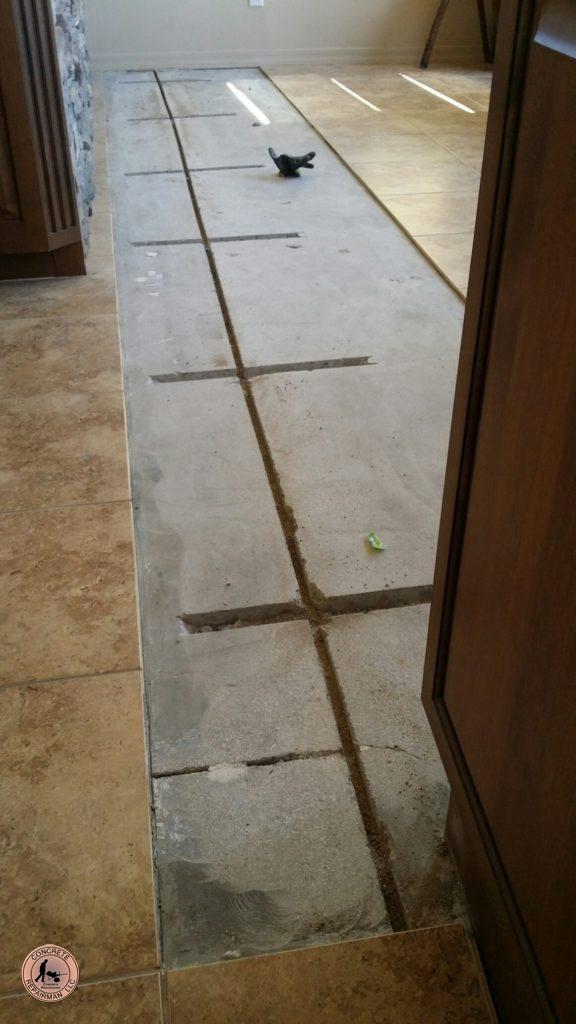

These confirm that at the time the slab was poured it was touching the wall. Look also for the stains or concrete debris on the Look for the gap between the edges of the slab and the foundation wall? In our photo found earlier on this page you can see the shrinkage of even an otherwise-perfect concrete floor slab with no visible cracks in the field of its surface if the floor was poured inside of an existingįoundation. If there is too much sulphate of lime or magnesia the cement must be rejected as dangerous to use.
Concrete slab crack repair stitching free#
(B, Fig I.) If there is too much free carbonate of lime the trouble may be corrected by allowing the cement to season in the air to allow the frere lime to slake. I.)Įxpansion cracks are due to too much free lime or magnesia in the cement. Shrinkage Cracks or "Contraction Cracks" are due to faulty workmanship, and may occur in the best of cements if mixed too rich or if allowed to dry out too quickly, or if not thoroughly mixed and trowelled (A, in Fig. In his Architect's Hand-Book on Cements Clarke (1899) described and offered this explanation for types of cracks occurring in concrete: This is characteristic of concrete (or mud) shrinking Line to the first crack, meandering again through the concrete. The crack will meander along in the concrete, taper to a stop, and then continue beginning in a parallel What is unique about shrinkage cracks in concrete is that they usually appear to be discontinuous, as shown in The cracks in this case ranged in width (measured across the crack) from "hairline" (less than 1/16") to aboutģ/32" in the basement floor slab of this particular home. The photograph of cracks above were taken of shrinkage cracks in a concrete slab floor in a home built in 2006. Later in the life of a foundation wall or floor slab - as we explain here. Shrinkage cracks such as shown in our photograph above are found in poured concrete, are easily recognizable, and can be distinguished from other types of cracks that occur Those likely to be important and potentially costly to repair. Types of foundation cracks, crack patterns, differences in the meaning of cracks in different foundation materials, site conditions, building history,Īnd other evidence of building movement and damage are described toĪssist in recognizing foundation defects and to help the inspector separate cosmetic or low-risk conditions from
Concrete slab crack repair stitching how to#
This article series describes how to recognize and diagnose various types of foundation failure or damage, such asįoundation cracks, masonry foundation crack patterns, and moving, leaning, bulging, or bowing building foundation walls. This article series discusses concrete cracking in slabs, walls, floors, and foundations, and describes the types of cracks that occur in poured ("placed concrete" by some experts) walls, slabs or floors and explains the risks associated with each, thusĪssisting in deciding what types of repair may be needed. Guide to Shrinkage Cracks in Poured Concrete Slabs We also provide an ARTICLE INDEX for this topic, or you can try the page top or bottom SEARCH BOX as a quick way to find information you need.


Possible problems from shrinkage cracking such as water or radon leaks. This document explains how to recognize shrinkage, evaluate, and repair cracks in poured concrete walls or floors, and discusses a few (minor) Do shrinkage cracks in poured concrete walls or floor slabs always need repair? How to recognize and evaluate shrinkage cracks in poured concrete slabs or floors. We address these questions: Are concrete floor cracks a structural problem? How to identify, evaluate, & repair shrinkage cracks in concrete floors,slabs, or foundations. We have no relationship with advertisers, products, or services discussed at this website. InspectAPedia tolerates no conflicts of interest.


 0 kommentar(er)
0 kommentar(er)
